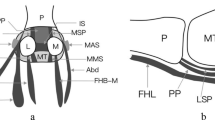Abstract
Objective
To characterize the MRI findings present in patients with clinically proven or suspected jogger’s foot.
Materials and methods
Ten years of medical charts in patients clinically suspected of having jogger’s foot and who had MRI studies completed were identified utilizing a computer database search. Six study cases were identified. The MRI examinations of the study cases and an age- and gender-matched control group were reviewed in a blinded fashion by two musculoskeletal radiologists. Size and signal intensity of the medial plantar nerve were measured and characterized. The medial foot musculature was assessed for acute or chronic denervation changes.
Results
The medial plantar nerve was found to have moderately increased T2 signal compared with normal skeletal muscle in 3/6 study group cases and markedly increased T2 signal in the remaining 3/6 cases. In all control cases, the nerve was reported to have T2 signal equal or minimally higher than normal skeletal muscle. The mean total size of the medial plantar nerve was significantly larger in the study group when compared with that in the control group at all measured locations (p < 0.04).
Conclusions
Abnormal thickness and T2 hyperintensity of the medial plantar nerve centered at the master knot of Henry are characteristic MRI findings in patients with jogger’s foot when compared with control subjects. Muscular denervation changes may also be seen, most commonly in the flexor hallucis brevis muscle.





Similar content being viewed by others
References
Peck E, Finnoff J, Smith J. Neuropathy in runners. Clin Sports Med. 2010;29:437–57.
Smith J, Dahm D. Nerve entrapments. In: O’Connor F, Wilder R, editors. The textbook of running medicine. New York: McGraw-Hill; 2001. p. 257–72.
Schon LC, Baxter D. Neuropathies of the foot and ankle in athletes. Clin Sports Med. 1990;9:489–509.
Schon LC. Nerve entrapment, neuropathy, and nerve dysfunction in athletes. Orthop Clin North Am. 1994;25:47–59.
McCluskey L, Webb L. Compression and entrapment neuropathies of the lower extremity. Clin Podiatr Med Surg. 1999;16:96–125.
Rask M. Medial plantar neuropraxia (Jogger’s foot). Clin Orthop Relat Res. 1978;181:167–70.
Havel PE, Ebraheim NA, Clark SE, et al. Tibial nerve branching in the tarsal tunnel. Foot Ankle. 1988;9:117–9.
Farooki S, Theodorou J, Sokoloff RM, Theodorou SJ, Trudell DJ, Resnick D. MRI of the medial and lateral plantar nerves. J Comput Assist Tomogr. 2001;25(3):412–6.
Delfaut EM, Demondion X, Bieganski A, Thiron M, Mestdagh H, Cotton A. Imaging of foot and ankle nerve entrapment syndromes: from well-demonstrated to unfamiliar sites. Radiographics. 2003;23:613–23.
Donovan A, Rosenberg ZS, Cavalcanti CF. MR imaging of entrapment neuropathies of the lower extremity part 2. The knee, leg, ankle and foot. Radiographics. 2010;30:1001–19.
DeMaeseneer M, Madani H, Lenchik L, Brigido MK, Shahabpour M, Marcelis S, et al. Normal anatomy and compression areas of nerves of the foot and ankle: US and MR imaging with anatomic correlation. Radiographics. 2015;35:1469–82.
Amrami KK, Felmlee JP, Spinner RJ. MRI of peripheral nerves. Neurosurg Clin N Am. 2008;19:559–72.
Chappell KE, Robson MD, Stonebridge-Foster A, Glover A, Allsop JM, Williams AD, et al. Magic angle effects in MR neurography. Am J Neuroradiol. 2004;25(3):431–40.
Acknowledgments
The authors thank Lanzino, Desiree J., Ph.D., P.T. for her help in editing the manuscript.
Author information
Authors and Affiliations
Corresponding author
Ethics declarations
All procedures performed in studies involving human participants were in accordance with the ethical standards of the institutional and/or national research committee and with the 1964 Helsinki declaration and its later amendments or comparable ethical standards.
Conflict of interest
The authors declare that they have no conflict of interest.
Additional information
Publisher’s note
Springer Nature remains neutral with regard to jurisdictional claims in published maps and institutional affiliations.
Rights and permissions
About this article
Cite this article
Collins, M.S., Tiegs-Heiden, C.A. & Frick, M.A. MRI appearance of jogger’s foot. Skeletal Radiol 49, 1957–1963 (2020). https://doi.org/10.1007/s00256-020-03494-w
Received:
Revised:
Accepted:
Published:
Issue Date:
DOI: https://doi.org/10.1007/s00256-020-03494-w




